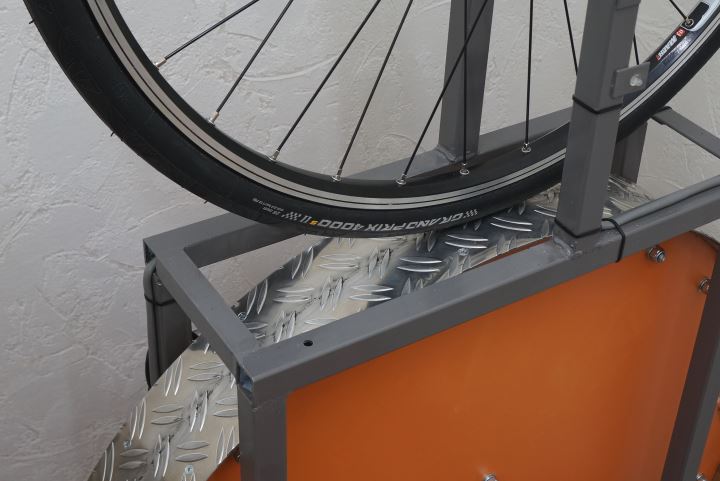Continental GP4000S II Comparison: 23, 25, 28 mm Compared

Note:
This article has been partially replaced by our Continental Grand Prix 5000 23, 25, 28, 32 mm comparison. The newer Continental Grand Prix 5000 article is much more detailed and includes
measurements with different inner tubes, measurements at 15% tire drop, and measurements at the same comfort level.
The Continental Grand Prix 4000S II aka the "GP4000S II" has been the most popular road bike tire of the last couple of years. In this review, I'll be comparing a 23C, 25C, and 28C Grand Prix 4000S II to see how weight, size, and rolling resistance compares across different sized road bike tires.
Ad Buy Continental Grand Prix 4000S II at Amazon.com
When testing the rolling resistance of bicycle tires, I always try to use tires of the same size as much as possible to make it easier to compare different brands and models as accurately as possible. Comparing a 20C tire with a 28C from another brand doesn't give any useful data in my opinion.
Because the GP4000S II is one of the most popular road bike tires and is available in different sizes (20C is available as well), it gives an excellent opportunity to explore the differences between wider and smaller road bike tires.
I've already reviewed the 25C GP4000S II some time ago. Go here to read the detailed review and view all data in the regular Bicycle Rolling Resistance format.
If you're new to the site, don't forget to take a look at the road bike overview page to see the full list of tires that we've tested.
Test set up
All tests were performed with the same wheel, tire, load, speed, and air pressures on the same day.
I've retested the same 25C GP4000S II I've tested in July 2014 for the 25C GP4000S II review. Results were within 0.5 watts, so I've used the data from 2014 to keep the 25C data consistent across the site.
Even though the 28C GP4000S has a maximum inflation pressure of 115 psi, measurements were taken at pressures of 120, 100, 80 and 60 psi. Keep this in mind when you're comparing, but I don't think anyone is going to use 120 psi in a 28C tire anyway.
Test conditions
- Speed of 18 mph / 29 km/h
- Total wheel load of 94 lbs/ 42.5 kg
- 700 x 17C wheel
- Temperature between 21-23 °C / 70-73 °F
- 100 grams Continental Race 28 Inner Tube
To read about all other test conditions and how tires are tested, please read the Rolling Resistance Test Conditions Explained page.
Test Results
Weight
Weight is within +/- 10 grams of manufacturer specifications for all tires. With the 23C being spot on, 25C being 10 grams lighter and the 28C 7 grams heavier than specified.
Size
On a 17C rim, at an air pressure of 100 psi, all versions of the GP4000S II measure about 2 - 3 mm wider than the specified size.
Rolling Resistance
This is where it gets really interesting. The general trend seems to be that, at the same air pressure, a wider tire has less rolling resistance.
Rolling resistance of the 25C GP4000S with a real width of 27 mm is close to the rolling resistance of the 23C GP4000S. The 28C GP4000S does have a noticeable lower rolling resistance but remember that this tire has a real measured width of 31 mm, which is a bigger step up than the 23C to 25C.
| GP4000S II 23C | GP4000S II 25C | GP4000S II 28C | |
|---|---|---|---|
| Manufacturer Weight | 205 grams | 225 grams | 260 grams |
| Measured Weight | 204 grams | 215 grams | 267 grams |
| Measured Width on 17C Rim | 25 mm | 27 mm | 31 mm |
| Measured Height on 17C Rim | 23 mm | 25 mm | 29 mm |
| Rolling Resistance 120 psi / 8.3 Bar | 12.5 Watts | 12.2 Watts | 11.6 Watts |
| Rolling Resistance 100 psi / 6.9 Bar | 13.1 Watts | 12.9 Watts | 12.0 Watts |
| Rolling Resistance 80 psi / 5.5 Bar | 14.1 Watts | 13.7 Watts | 12.7 Watts |
| Rolling Resistance 60 psi / 4.1 Bar | 16.2 Watts | 15.5 Watts | 14.1 Watts |
| CRR 120 psi / 8.3 Bar | 0.00375 | 0.00366 | 0.00347 |
| CRR 100 psi / 6.9 Bar | 0.00393 | 0.00387 | 0.00360 |
| CRR 80 psi / 5.5 Bar | 0.00423 | 0.00411 | 0.00381 |
| CRR 60 psi / 4.1 Bar | 0.00486 | 0.00465 | 0.00423 |
Conclusion

The bigger the tire, the lower the rolling resistance at the same air pressure. When you run lower air pressures, the differences get even bigger. At a comfortable 80 psi, you're only giving up 2-3 watts for a pair of tires when going for the 28C size. That's good to know when you decide to go for a bigger tire because you like a more comfortable ride or ride on bad roads with potholes a lot.
Off-course, what will be won in the rolling resistance department, will be lost in the aerodynamics department. I'm not sure at what kind of speed this turnover point would be. This also depends greatly on the tire/wheel combo. A 28C tire on a rim that is designed for a 23C tire will perform poorer.
All in all, I think the differences aren't that significant, in particular between the 23C and 25C tires. I'm looking forward to repeating this test with other tires to see if we can apply these results to other tires as well.
Ad Buy Continental Grand Prix 4000S II at Amazon.com
